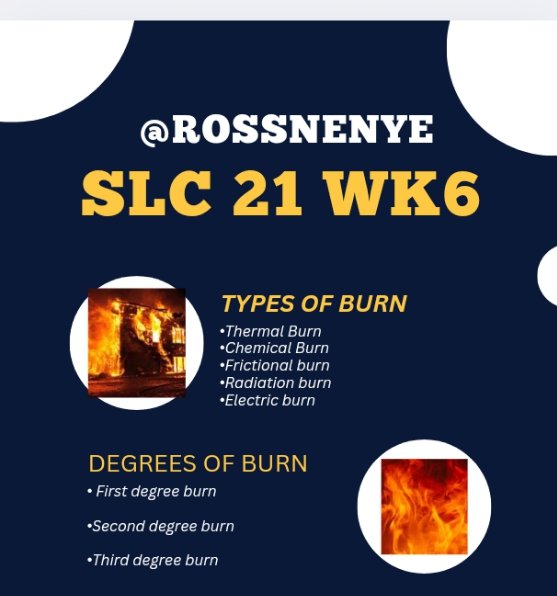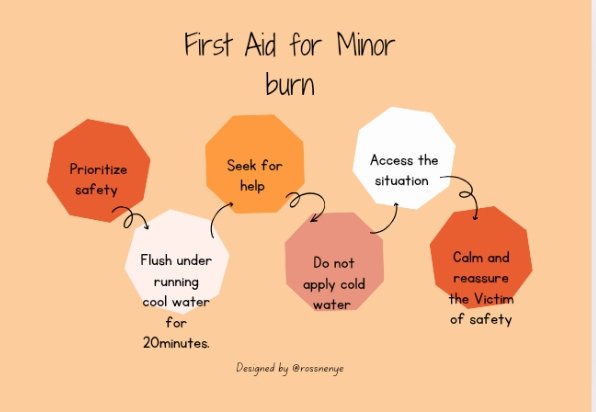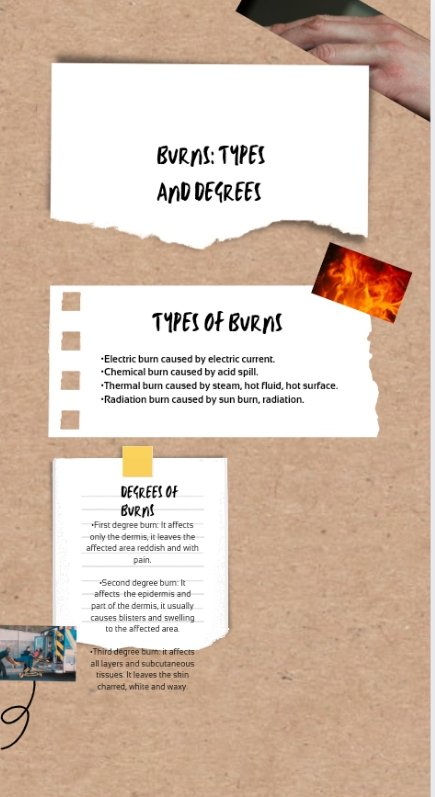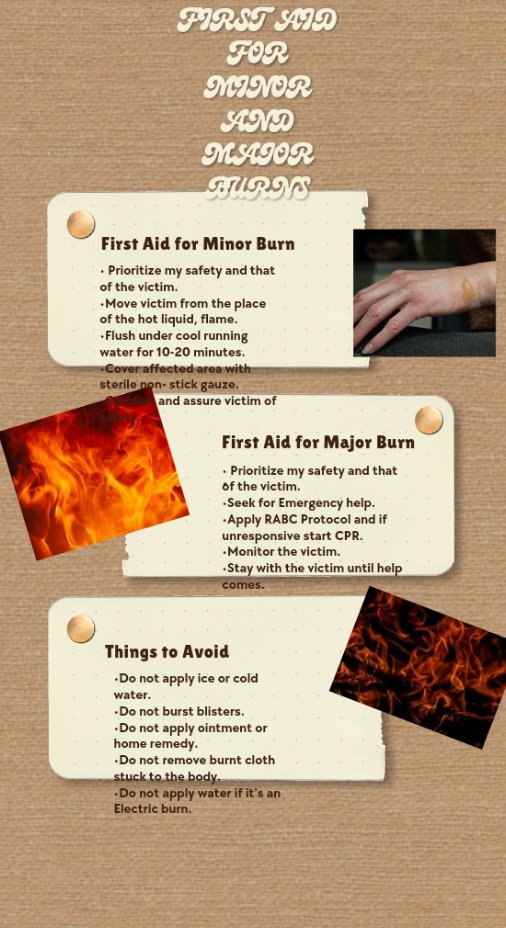
Q1:Write a detailed first aid response for the following scenario:
| " You witness a child accidentally spilling hot tea on their arm. What immediate steps will you take? |
|---|
- Safety
I would apply the DRABC Protocol like we learnt previously and prioritize my safety and that of the Victim by looking out for potential hazard like live wire, Chemicals, or flames, hot liquid and moving the Victim to safety.
I would wear gloves/wrapper around my hands or any safety equipment if they is any.
- Stopping the burning process
The next step I will take is to stop the burning process inorder to prevent further injury by moving the Victim away from the source of hot liquid.
I would calm down the burn by flushing the affected area under running water for about 10-20minutes in order to decrease the temperature of the affected skin and reduce tissue damage. I would make sure it's cool water. I would also avoid using cold water which can further damage to the tissues.
- Cleaning
After about 20minutes, I would gently clean the burnt place with mild soap and water.
- Dressing
I would use a sterile non-stick dressing or clean Gauze to cover the affected area in order to prevent contamination.
- Pain management
I would offer the victim pain relief like ibuprofen.
- Hydration
I would offer the victim drinking water Incase the burning is large.
I will comfort and reassure the Victim that he/she will be fine and I take care of the situation.
I would also seek for medical attention Incase an Infection occurs by calling the Medical Emergency number of my Country, telling them the situation of the Casualty and the location.
I will keep monitoring and stay with the patients in order to avoid complications like shock until help comes.
| What actions will you avoid? |
|---|
I would not break any blisters in order to prevent the risk of infection.
I would not apply any home remedy like Egg white, toothpaste, butter and ointments directly on the burn.
I would not flush the affected area under running cold water in order to prevent additional tissue damage.
I would not apply direct pressure on the affected area inorder to avoid aggravating the injury.
I would not wrap the affected area tightly inorder to avoid restricting blood circulation.
| Include considerations for burn severity and explain your reasoning. " |
|---|
- Assess the Burn severity
I would also assess the degree of the burn to know if it's first degree by observing the appearance of the skin to know if it's reddish and swollen, this type of burn can be treated at home. If there is blisters swollen and the the large part of the skin is burnt, then i would know is second degree burn and I would apply first aid and then call the Medical Emergency for help inorder to avoid complications. For third degree burn, I would look out for charred, white and waxy skin and I would immediately call the Medical Emergency for help because it's only them that can handle the situation.
| Q2: "A worker in a warehouse suffers an electrical burn after touching exposed live wires. The burn site shows entrance and exit points, with damage to the skin and underlying tissues. What are the immediate first aid actions you should take, and what critical steps should you avoid? How does this differ from treating thermal burns?" |
|---|

- Safety
The first major step I will take is to prioritize my safety first and also that of the Victim by making sure that the Electrical source is completely disconnected before approaching the Casualty inorder to prevent putting myself and the Casualty into risk.
- Call for help
I would immediately call the Emergency number of my Country, telling them the Condition of the Casualty and the location.
- Access the Situation
The next step I will take is the ABC protocol by doing the following.
Responsive
I would check if the Victim is responsive by gently asking him if his okay and if his unresponsive, then i will go on to check Airways, Breathing and Circulation (ABC) immediately
- Airways
I would ensure that his airways is completely open, checking out for obstruction, if their is any I will open the airways by using the head tilt method.
- Breathing
I would also assess his breathing for 10seconds and if his breathing is not normal then I would start CPR immediately.
- Circulation
I would also check his pulse Incase of any sign of severe bleeding I would control that. I would also look out for signs of shock like bluish skin, rapid breathing and cold sweat.
- Treating the burn
This is an Electric burn I would cover the wounded area with a clean dry cloth or bandage inorder to avoid infection, I would also ensure that I didn't touch the wound while applying the clean dry cloth to prevent causing more Injuries
I would also monitor the Victim to avoid shock by lying him in a stable surface and keeping him warm. I would also stay with him until Medical Emergency comes for help
I would also avoid cooling the burn with water inorder to avoid hypothermia shock.
- Critical steps I would avoid
I would not apply water in the affected place inorder to prevent hypothermia shock.
I would also avoid cleaning the place inorder to avoid contamination.
I would not burst any blisters
I would ensure not to touch the burn directly.
| Differences between Electrical and Thermal Burn |
|---|
| Electrical Burn | Thermal Burn |
|---|---|
| More risky and it requires urgent medication attention | Less risky and most times It can be treated with first aid treatment. |
| It doesn't require flushing under water, flushing it under water will cause hypothermia shock. | It requires flushing under cool running water water for about 20minutes |
| It affects mostly internal organs and tissues. | It affects mostly Epidermis. |
| Q3: "A worker in a factory accidentally spills a strong acid on their arm, causing immediate pain, redness, and blistering. A colleague tries to wash it off with water but notices the burn spreading." |
|---|
| a. Identify the type of burn. |
|---|
In this case in which a worker mistakenly spills strong acid arm on his arm it's a Chemical burn which is as a result of the strong acid poured on the person's skin and also all the symptoms pointed out like blisters, redness and immediate pain are caused by Chemical burn.
| b. What went wrong during the initial first aid? |
|---|
What went wrong was that the response was't sufficient, the first person didn't use water to flush the acid away early enough, secondly the water used in flushing the affected part wasn't enough and it resulted to several burn.
| c. Propose the correct first aid steps and explain why each step is important. |
|---|
- Safety
I would prioritize my safety and also that of the victim by ensuring that they is no more Chemical than can cause harm to us.
- Call for help
I would call the Emergency medical number of my Country, telling them the Condition of the Victim and the location.
I would wear hand gloves if there is any and carefully remove all the contaminated clothing, including jewelries and accessories, inorder to stop the spread of the burn to other body parts.
I would flush the affected part thoroughly under running cool water for atleast 20 minutes without stopping inorder to dilute the acid.
I would also avoid neutralizing the acid with another chemical that can cause exothermic reaction thereby causing more damage.
I would cover the affected part loosely with a clean dry bandage or clean cloth inorder to prevent infection
I would stay with the victim until the Medical Emergency comes for help.
| Q4:You are a first responder in a rural area. Two people are injured in a house fire: |
|---|
| Person A has a large area of third-degree burns but is conscious and calm. |
|---|
| Person B has second-degree burns on both legs and is in severe pain. |
|---|
| You can only help one person immediately due to resource constraints. |
|---|
| Whom do you prioritize, and why? Support your decision with medical and ethical reasoning |
|---|
Medical reasoning
So in this case, person A has third degree burn, while person B has second degree burn. Even though Third degree burn is more serious because it can cause tissue damage, I would Help the person B first for the following reasons.
Person B is in severe pains and his condition can worsen if immediate attention is not administered while person A suffers third degree burn which causes nerve damage therefore his not feeling pain. Secondly the person A requires Medical attention and may also require Surgery and intensive care which I can't offer whereas I can offer first aid to the Person B until help comes
- Ethnical reasoning
From ethical reasoning, helping the person B is the best thing to do because he can be treated with first aid treatment while the person A can only helped by Medical professional which I can't offer. I would only call for Emergency Medical help for Person A after stabilizing the person B.
| Q5: Create an infographic on burn management. Include the following: |
|---|
a. Types of Burns and Their Causes (Electrical, Thermal, etc)
b. Different types of burns (1st, 2nd, and 3rd degree)

c. First aid steps for minor and major burns
d. What NOT to Do During Burn First Aid." Use visuals and short explanations for each point.

I would love to appreciate the teachers, @abdu.navi03 and @huzaifanaveed1
for impacting this knowledge on us. Thanks for reading my post, I invite @chommygift, @eveesin and @triple-e to participate in this contest.
Student Name: @rossnenye
Overall grade: 9.4
Plagiarism Check: Pass
AI Use: no
General Feedback: The student has shown an excellent understanding of this week's course. There were a few shortcomings which I'm sure will be avoided in the upcoming posts.
Thank you.
Regards,
@huzaifanaveed1
Downvoting a post can decrease pending rewards and make it less visible. Common reasons:
Submit